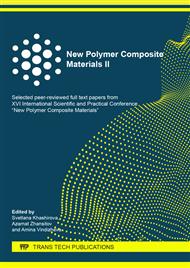[1]
A.S. Kolosova, M.K. Sokolskay, I.A. Vitkalova, A.S. Torlova, E.S. Pikalova, Modern polymer composite materials and their application, International Journal of Applied and Basic Research. 1 (2018) 245-256.
Google Scholar
[2]
A.A. Tager, Physical chemistry of polymers, Scientific world, Moscow, 2007, pp.76-150.
Google Scholar
[3]
Zh.A. Boeva, V.G. Sergeev, Polyaniline: Synthesis, Properties and Applications, Polymer Sci. Part C, 56 (2014) 153-164.
Google Scholar
[4]
T.A. Skotheim, J.R. Reynolds, Handbook of Conducting Polymers. 3rd ed. Conjugated Polymers. Processing and Applications, Taylor & Francis Group, London, New York, 2007. pp.156-257.
Google Scholar
[5]
A.G. Zabrodsky, M.E. Kompan, V.G. Malishkin, I.Yu. Sapurina, Carbon-based polyaniline as an anode catalyst - a way to create free fuel cells , Letters to the Journal of Thermophysics. 32 (2006) 50-59.
Google Scholar
[6]
M.E. Kompan, I.Yu. Sapurina, V. Babayan, N.E. Kazantceva, Electrically conductive polyaniline - a molecular magnet with the possibility of chemical control of magnetic properties, Solid state physics. 54 (2012) 2275-2281.
DOI: 10.1134/s1063783412120190
Google Scholar
[7]
Yu.N. Biglova, R.B. Salikhov, I.B. Abdrakhmanov, T.R. Salikhov, I.N. Saphargalin, A.G. Mustaphin, Preparation and study of soluble functionalized polyanilines, Solid State Physics. 59 (2017) 1228-1233.
DOI: 10.1134/s106378341706004x
Google Scholar
[8]
T.A. Borukaev, A.Kh. Shaov, A/Kh. Malamatov, Yu.A. Malkanduev, Obtaining azomethines based on m-phenylenediamine and substituted benzaldehydes capable of oxidative polymerization, KBSU News. 7 (2017) 17-21.
Google Scholar
[9]
A.V. Orlov, S.Zh. Ozkan, G.N. Bondarenko, G.P. Karpacheva, Oxidative polymerization of diphenylamine. Synthesis methods, polymer structure, Polimer Sci. Part B. 48 (2006) 126-130.
DOI: 10.1134/s1560090406010027
Google Scholar
[10]
S.Zh. Ozkan, G.N. Bondarenko, G.P. Karpacheva, Interfacial oxidative polymerization of phenothiazing, Polimer Sci. Part B. 51 (2009) 855-863.
Google Scholar
[11]
J. Stejskal, A. Riede, D. Hlavata, J. Prokes, M. Helmstedt, P. Holler, The Effect of Polymerization Temperature on Molecular Weight, Crystallinity and Electrical Conductivity of Polyaniline, Synthetic, Synth. Met. 96 (1998) 55-61.
DOI: 10.1016/s0379-6779(98)00064-2
Google Scholar
[12]
D.V. Zhuzhelsky, V.D. Ivanov, V.V. Maleev, Electrochemical study of polyaniline films formed on an ITO substrate during cathodic oxygen reduction, Electrochemistry. 42 (2006) 782-789.
Google Scholar


